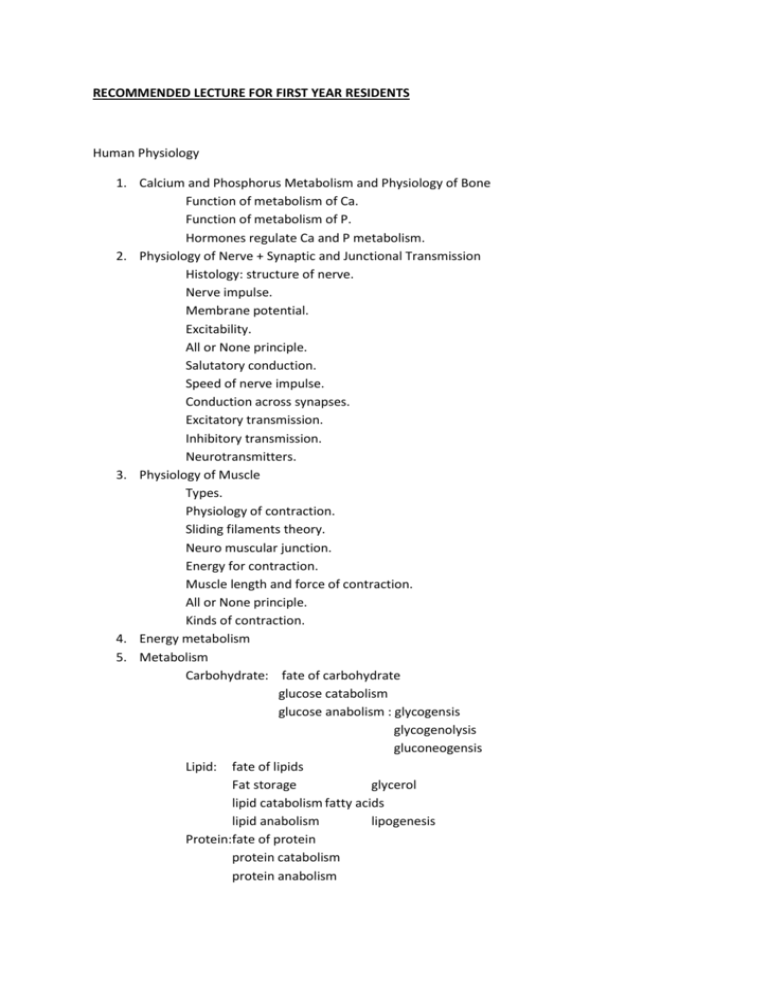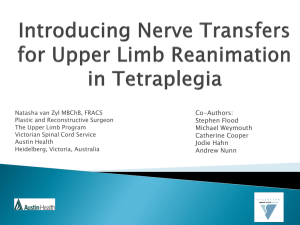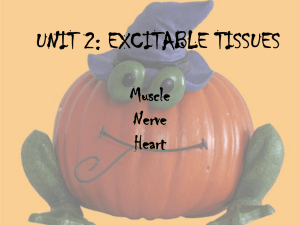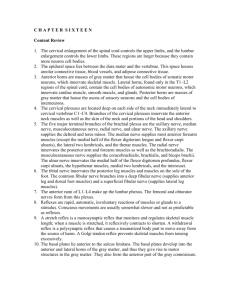RECOMMENDED LECTURE FOR FIRST YEAR RESIDENTS
advertisement

RECOMMENDED LECTURE FOR FIRST YEAR RESIDENTS Human Physiology 1. Calcium and Phosphorus Metabolism and Physiology of Bone Function of metabolism of Ca. Function of metabolism of P. Hormones regulate Ca and P metabolism. 2. Physiology of Nerve + Synaptic and Junctional Transmission Histology: structure of nerve. Nerve impulse. Membrane potential. Excitability. All or None principle. Salutatory conduction. Speed of nerve impulse. Conduction across synapses. Excitatory transmission. Inhibitory transmission. Neurotransmitters. 3. Physiology of Muscle Types. Physiology of contraction. Sliding filaments theory. Neuro muscular junction. Energy for contraction. Muscle length and force of contraction. All or None principle. Kinds of contraction. 4. Energy metabolism 5. Metabolism Carbohydrate: fate of carbohydrate glucose catabolism glucose anabolism : glycogensis glycogenolysis gluconeogensis Lipid: fate of lipids Fat storage glycerol lipid catabolism fatty acids lipid anabolism lipogenesis Protein:fate of protein protein catabolism protein anabolism 6. Nutrition: Essential dietary components. Caloric intake and distribution. Mineral requirements. Vitamins. 7. Physiological function of thyroid gland: Formation, storage and release of thyroid hormones. Function and control of thyroid hormones. 8. Physiological function of adrenal gland: Adrenal cortex: mineralcorticoids glucocorticoids gonadocorticoids Adrenal medulla: epinephrine nor epinephrine 9. Control of adrenal hormones 10. Physiological function of pituitary gland Hormones of adenohypophysis Hormones of neurohypophysis Control of pituitary hormones Physiological function of gonads 11. Gastrointestinal secretion Mouth saliva Esophagus Stomach gastric juice and hormone stomach gastrin Pancreas as endocrine and exocrine liver Gall bladder Intestine enzymes and hormones Digestion of carbohydrate, protein, fat, nucleic acid Absorption of carbohydrate, protein, fate, water and electrolytes Vitamins 12. The circulatory system Blood Lymph Immune mechanism 13. The heart as a pump Conduction system Blood flow through the heart Cardiac cycle Cardiac output Electrocardiogram 14. Respiration Pulmonary function Gas transport between lungs and tissues Regulation of respiration 15. Renal function Glomerular filtration Tubular reabsorption Tubular secretion Formation and excretion of urine 16. Saliva Production Chemical characteristics (pH) Function 17. Mastication and deglutition Requirements of proper mastication Stages of deglutition 18. Dental caries Causes Theories Prevention PHYSIOLOGY OF NERVE AND MUSCLE CELL Nerve: Nerve cell (morphology and excitation) Electrical phenomena in nerve cell Ionic basis of excitation and conduction Properties of mixed nerves Nerve fibres, types and function Muscles: Morphology Electrical phenomena and ionic fluxes Metabolism and energy sources Cardiac muscle – morphology electrical and mechanical properties metabolism Smooth muscle - morphology visceral smooth muscle multi-unit smooth muscle Synaptic and junction transmission Synaptic transmission – anatomy electrical events at synapses inhibition and facilitation at synapses chemical transmission of synaptic activity Neuro muscular transmission: Myoneural junction Nerve endings in smooth and cardiac muscle Reflexes: Reflex arc Mono synaptic arc Poly synaptic arc Cutanous, deep and visceral sensation: Pathways Touch Proprioception Temperature Difference between somatic and visceral sensory mechanism Referral and inhibition of pain The autonomic nervous system: Anatomy Chemical transmission at autonomic junction Responses of effector organs to autonomic nerve impulse Circulation: Blood WBC Immune system Platelets RBC Blood types Plasma Haemostasis Lymph Heart: Structure of heart Origin and spread of cardiac impulse Cardiac cycle Heart sounds Elector cardiograph Cardiac arrhythmias Electrocar biographic cardiac diseases and other cardiac systems Heart as a pump: Mechanical events of the cardiac cycle Cardiac output Cardiovascular homeostasis in health and disease: Compensation for gravitational effects Exercises Haemorrhagic shock Fainting Heart failure Hypertension Respiration: Pulmonary function Properties of gases Mechanism of respiration Gas exchange of lung Gas transport between lung and tissue: Oxygen transport Buffers in blood Carbon dioxide transport Regulation of respiration: Neural control of breathing Chemical control of respiration Regulation of respiratory centre activity Respiratory adjustment in health and disease Hypoxia Hypoxic hypoxia Hypercapnia and hypocapnia Artificial respiration Endocrinology and metabolism Energy metabolism Energy balance Carbohydrate metabolism Protein metabolism Thyroid gland Anatomy Formation and secretion of thyroid hormone Effect at thyroid hormone Regulation of thyroid gland Adrenal medulla and adrenal cortex Adrenal medulla – structure, function of medullary hormone regulation of adrenal medullary secretion Adrenal cortex - structure, transport of cortical hormones physiologic effect of glucocorticosteroid pharmacological effect of glucocorticoid Hormonal control of calcium metabolism Calcium and phosphorous metabolism Effect of vitamin D and hydroxycholecalciferols Effect of parathyroid gland Calcitonin Pituitary gland Anatomy Intermediate lobe hormone Growth hormone Digestion and absorption Carbohydrates Protein and nucleic acids Lipids Absorption of water and electrolytes Absorption of vitamins and minerals Regulation of gastrointestinal function Gastrointestinal hormones Mouth and esophagus Stomach Regulation of gastric secretion and motility Exocrine portion of the pancreas Liver and biliary system Small intestine Colon Functional anatomy Renal circulation Glomerular filtration Tubular function Water excretion Regulation of Na+ and electrolyte excretion Regulation of K+ excretion 1. Embryology of head and neck Pharyngeal aches Pharyngeal pouches Pharyngeal clefts 2. Development and growth of: Face Jaws Teeth Tongue Palate Thyroid gland 3. Fascia of the neck 4. The posterior triangle of the neck 5. The anterior triangle of the neck Muscles Thyroid and parathyroid glands 6. Trachea and larynx 7. Oesophagus 8. The suprahyoid region 9. The side of the neck 10. The root of the neck 11. The scalp and the muscles of the face 12. Cranial nerves 13. Blood supply of the face: Arterial blood supply Venous drainage Lymphatic drainage 14. Nerve supply of the face: Sensory Motor Parasympathetic 15. Contents of the infratemporal fosse 16. Carotid artery and its branches External carotid Internal carotid 17. The nose and paranasal sinuses 18. Anatomy of the mouth: Hard and soft palate 19. Enamel Development Composition and structure 20. Dentine Development Composition and structure 21. Pulp 22. Cementum 23. Periodontal membrane 24. The alveolar bone and jaws Structure and changes 25. The mucous membrane of the mouth 26. Teeth eruption and shedding ANATOMY OF THE HEAD AND NECK The skull : cranium Facial skeleton The Face The Scalp Muscles of the face: Muscles of the eye Muscles of the nostrils Muscles of the lips and cheek Nerve supply of the facial muscles Sensory nerve supply of the face Blood supply of the face Nerve and blood supply The Pre-auricular region Masseter muscle Parotid gland Infra-temporal fossa Lateral pterygoid muscle Medial pterygoid muscle Maxillary artery Pterygoid plexus Mandibular nerve The posterior part of the infra-temporal fossa Carotid sheath The pterygo-palatine fossa Contents Maxillary nerve Pterygo-palatine ganglion The nose External nose Cavity of the nose Lateral wall of the nose Nasal chonchae Blood and nerve supply of the nose Nasal septum Paranasal sinuses Development of sinuses Maxillary sinus: Relationship of teeth Osmium of the antrum Mucous membrane Nerve supply Ethmoidal sinuses Posterior ethmoidal sinus Middle ethmoidal sinus Anterior ethmoidal sinus Sphenoidal sinus Frontal sinus Mouth Vestibules Teeth Cavity of the mouth Hard palate Nerve and blood supply of the hard palate Tongue Mucous membrane Microscopy of tongue Muscles of the tongue Movements of the tongue Blood and nerve supply of the tongue Floor of the mouth Mylo hyoid muscles Genio hyoid muscles Hyoglossus muscle Submandibular duct Hypo glossal nerve Lingual nerve Submandibular ganglion Lingual artery The pharynx Wall of the pharynx Pharyngo-basilar fascia Sensory supply of pharynx Blood supply of pharynx Muscles Superior constrictor muscles Middle constrictor muscles Inferior constrictor muscles Motor supply of pharyngeal constrictors Pharyngeal plexus Soft palate Tensor palatine muscles Palate muscle elevators Uvula Palate pharyngeus muscle Palate glossus muscle Structure of soft palate Blood supply Nerve supply Movements and function Larynx Function Skeleton of larynx: Cricoid cartilage Arytenoid cartilage Thyroid cartilage IMPORTANT NERVES OF THE HEAD AND NECK The trigeminal nerve (fifth cranial nerve) Ophthalmic division Maxillary division Mandibular division The facial nerve ( seventh cranial nerve) The glossopharyngeal nerve (ninth cranial nerve) The vagus nerve (tenth cranial nerve) The accessory cranial nerve (eleventh cranial nerve) The hypoglossal nerve (twelfth cranial nerve) IMPORTANT ARTERIES OF THE HEAD AND NECK The facial artery The lingual artery The superior thyroid artery The maxillary artery The ophthalmic artery The intrinsic muscles of the larynx The sphincter of the inlet Muscles of the focal cord The extrinsic muscles of the larynx Orbit Contents Muscles of the orbit Nerves of the orbit Temporo-mandibular joint Capsule Disc Temporo mandibular ligament Spheno mandibular ligament Movements of the joint Fascia of the neck Investing layer of deep cervical fascia Prevertebral fascia Pretracheal fascia The carotid sheath The posterior triangle of the neck Contents Cervical plexus The cutanous nerves of the neck The sterno-mastoid muscles The anterior triangle of the neck Geniohyoid muscle Sternohyoid muscle Omohyoid muscle Thyrohyoid muscle Sternothyroid muscle Thyroid gland Veins of the head and neck The anterior facial vein The posterior facial vein The external jugular vein The anterior jugular vein The lingual vein Lymph drainage of the head and neck Deep cervical lymph nodes Lymph drainage of the face Lymph drainage of the tongue BASIC SCIENCE IN GENERAL AND DENTAL ANATOMY Embryology of head and neck Pharyngeal arches Pharyngeal pouches Pharyngeal clefts Development and growth of face, jaws, teeth, tongue, palate and thyroid gland The facia of the neck The posterior triangle The anterior triangle of the neck Muscles Thyroid and parathyroid gland The trachea and larynx The esophagus The suprahyoid region The side of the neck The root of the neck The scalp and muscles of the face Cranial nerves Blood supply of the face Nerve supply of the face Contents of infra temporal fossa Carotid artery and its branches The nose and paranasal sinuses Anatomy of mouth, hard and soft palate Enamel, dentine, development, composition and structure Pulp Cementum and periodontal membrane Periodontal membrane The alveolar bone and jaws, structure and changes BASIC LECTURES IN PATHOLOGY 1. The role of genetics in medicine 2. Cell and tissue damage 3. Acute inflammation 4. Infection 5. Wound healing 6. Chronic inflammation 7. Immune response 8. Some bacterial infection: Pyogenic Anaerobic Mycobacterial Spirochetal 9. Viral infection 10. Disorders of growth 11. Neoplasm 12. Ionizing radiation and its effects 13. Disorders of circulation 14. Shock and haemorrhage 15. Fever and hypothermia 16. Amyloidosis 17. Disorders of the blood 18. Skin diseases with oral manifestation 19. Disorders of endocrine glands 20. Diseases of the heart 21. Diseases of blood vessels 22. Diseases of liver PATHOLOGY The Normal Cell Structure: Cell membrane functions: Cell movement Cell recognition Cell growth Cell adhesion Transfer function Membrane: structure in relation to function The Nucleus: Nuclear membrane Chromatin DNA RNA The Cytoplasm: Mitochondria Lysosomes Endoplasmic reticulum The Cell Cycle: Mitosis Miosis Principles of Virology: Properties of viruses Size and shape Life cycle Tissue reaction to viruses Immunity to viral infection Viral infections of human beings: Viruses affecting the respiratory tract Viral hepatitis Herpes virus infection Disorders of growth: Hyperplasia Hypertrophy Atrophy Abnormalities of cellular differentiation: Metaplasia types Epithelial metaplasia Connective tissue metaplasia Tumour Inflammatory reaction Acute inflammation causes of acute inflammation Changes in acute inflammation The vascular changes Exudation and swelling Changes in other tissue components Local sequelae of acute inflammation The chemical mediators in acute inflammation Wound healing Regeneration: repair Wound contraction Causes of contraction Granulation tissue formation Healing of skin wounds by primary intention Healing by secondary intention Repair in the central nervous system Healing in bone Acute pyogenic infection General bacteriology of pyogenic infections Staphylococci Streptococci Gram-negative intestinal bacilli Pneumococcus Wound infection (sources of wound infection) Anaerobic wound infection Gas gangrene Tetanus, pathogenesis and prophylaxis Tuberculosis, syphilis and actinomycosis Important chronic infection Histoplasmosis Fungal infection Candidiasis Protozoal infections Toxoplasmosis Some chronic infections: Cat scratch disease Sareodoidosis The relation between genetics and disease Diseases inherited as a dominant characteristic Diseases inherited as a recessive characteristic Diseases inherited as a sex-linked recessive characteristic Diseases inherited as a sex-linked dominant characteristic Diseases associated with genetic errors Cell response to injury Biochemical lesions Changes associated with accumulation of water in the cell 1. Cloudy swelling 2. Vacuoler degeneration 3. Hydropic degeneration Changes associated with the re-accumulation of FAT: Nature of the degenerative changes Nuclear changes Cytoplasmic changes Nature of fatty changes Hyaline degeneration Cell death and necrosis Types of necrosis: Coagulative necrosis Colliquative necrosis Fat necrosis Necrosis of collagen Chronic inflammation Causes Classification of the types of chronic inflammation Features of chronic inflammation Immune response Antigen characteristics Antibody types Nature and properties of immunoglobulins The antibody forming tissues Theories of immunoglobulin antibody production Specific and non-specific immunity Hypersensitivity Diseases mediated by immunological mechanism PATHOLOGY Cell and tissue damage Degeneration Changes associated with accumulation of water Changes associated with accumulation of fat Chemical consideration of cell damage Cell death and necrosis Types of necrosis Changes in necrotic tissue Acute inflammation Causes Changes : vascular response Inflammatory exudate Local sequelae of acute infection Chronic inflammation Causes Classification Features and components of chronic inflammation General effects of chronic inflammation Wound healing Causes of tissue destruction Aspects of healing process Healing by primary intention Healing by secondary intention Regeneration Organization Factors affecting wound healing Healing of skin wound fracture Healing of dental extraction wound Complications of wound healing Infection Body defences against infection Body response to infection Some important bacterial infections Pyogenic Anaerobic Mycobacterial Spirochetal Mycoplasmal infections Chlamydial infections Rickettsial infections Immune response Non specific immunity Specific immunity Humoral immunity Cell mediated immunity Antigen antibody union Factors influencing antibody production Functional steps in the immune response Hypersensitivity reaction Some autoimmune diseases Viral infection Viruses, general properties, classification Chemical constituents Life cycle and reproduction Some important viral diseases Hepatitis Mumps Herpes viruses Immunity to viral infections Disorders of growth Excessive growth Hyperplasia Pseudoneoplastic hyperplasia Hypertrophy Diminished growth Atrophy Abnormalities of cellular differentiation Metaplasia Dystrophy Neoplasia Definition Possible causes Classification (Benign-malignant), (Canciroma-sarcoma) Stages of carcinogenesis Spread of malignancy Effect of benign and malignant tumours Pre-malignancy Ionizing radiation Effects of radiation on the body Effects of total body irradiation Radiotherapy Disorders of circulation Active hyperaemia Venous congestion Ischemia – thrombosis Embolism Haemorrhage Oedema Fever and hypothermia Mechanism of temperature regulation Fever: clinical features – pathogenesis Hypothermia: infants Adults Metabolic disorders Diabetes mellitus Gout Disorders of Ca. Metabolism Diseases of endocrine glands Hyperthyroidism Hypothyroidism Disease of hypothalamus Disease of adrenal gland (Cushings Syndrome) Disease of pituitary gland (hyper and hypo secretion) Hyperparathyroidism – hypoparathyroidism Disease of bone-muscle of joint Bone - developmental anomalies Fractures Infections Metabolic disorders Muscles inflammation Atrophy Muscular dystrophy Myasthenia gravis Joint - Acute arthritis Tubercles arthritis Ankylosing spondylitis Osteoarthritis Specific disease of TMJ Some skin diseases with oral manifestation Dermatitis and eczema Papulesquamous eruptions Vesiculobollus disease Intra epidermal vesicles Diseases of the heart Congenital : etiology Signs and symptoms Individual lesions of chronic heart diseases Acquired heart disease Hypertensive heart disease Rheumatic heart disease Endocarditis Valvular heart disease Heart failure Diseases of the liver Function of the liver Degenerative conditions Fatty changes Hepatic necrosis Alcohol and the liver Hepatitis Cirrhosis Jaundice Disease of the salivary glands Developmental anomalies Infection (bacterial and viral) Obstruction and traumatic lesions Salivary duct fistula Mucocele Functional disorders Xerostomia Sialosis Sjogrens and Sicca syndrome Amyloidosis Classification of amyloid disease Effects of amyloid disease Nature and pathogenesis of amyloid Disorders of the blood Anaemias Polycythaemia Neutrophilia Neutropenia Lymphocytosis Monocytosis Eosinophilia Leukaemias Multiple myeloma Bone marrow aplasia Agranulocytosis Haemorrhagic disease Shock and Haemorrhage Haemorrhage: causes Types Effects Shock: Primary Secondary Gingivitis and periodontitis Hyperplastic gingivitis Hormonal gingivitis Desquamative gingivitis Necrotizing gingivitis Allergic gingivitis Periodontitis – causes Clinically Pocket formation Periodontal abscess Juvenile periodontitis Occlusal trauma Diseases and tumours of the oral mucosa White lesions of oral mucosa Ulcerative lesions of oral mucosa Pigmented lesions of oral mucosa Benign tumours of epithelial and connective tissue Malignant tumours of epithelial and connective tissue Salivary gland tumours Benign: Pleomorphic adenoma Monomorphic adenoma Cystadenolymphoma Maligant: Adenocarcinoma Malignant pleomorphic adenoma Adenocystic carcinoma Acinic cell carcinoma Diseases of blood vessels Diseases of arteries Diseases of veins Diseases of capillaries








